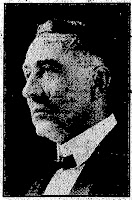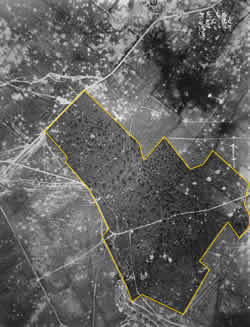 |
| Credit: Major Bennett Bus, Flickr.com, VB5215 |
The white and green buses operated by Peterborough Transit
are on nearly every major arterial road in the city. The Major Bennett #12 bus
is a familiar sight on Aylmer Street and near the newly renovated Lansdowne
Place Mall. The commuters that use the Major Bennett route likely haven’t
considered the origin of the name. Major Bennett Drive was named after
Peterborough’s first casualty of the First World War, Major George Bennett.
 |
| Photograph of Major G.W. Bennett, Credit: Peterborough Examiner, 1915 |
George Bennett was a prominent resident of the small city of
18,000 people. He was born in 1864 in North Monaghan Township and worked a
civil servant for the Government of Ontario. He rose to the prestigious rank of
Superintendent of the Department of Public Works overseeing provincial roads in Northern Ontario. The tall dark
haired 49 year old bachelor had served with the local Peterborough militia for
over 25 years. After many nights at the Peterborough Armouries on George
Street, Bennett received his officer’s commission with the 57th "Peterborough
Rangers" Regiment.
 |
| Picture of troops in Ypres in June 1915 with bayonets. Note how the Belgian countryside still had trees - not yet mud and siege warfare. Credit: Wikipedia Commons |
When Britain declared war on Germany in August 1914, 115 soldiers
from Peterborough’s 57th Regiment rushed to volunteer for overseas
service. The eager Peterborough volunteers that were selected for service were
to be led by Peterborough’s own Major Bennett. The first batch of Peterborough
recruits were assigned to the 1 Company, 2nd Battalion (Eastern
Ontario) in the Canadian Expeditionary Force. After months of training in
Quebec, and in England, they took their place in the front line against the
Germans.
 |
| Route of 2nd Battalion on 22 April 1915 Credit: The History of the 2nd Canadian Battalion (Eastern Ontario Regiment), C.E.F., 1947 |
At 7pm on 22 April 1915, the Bennett’s battalion witnessed
the first use of chlorine gas in warfare. Click here to read about the attack. Bennett and his men were stationed in reserve in rest billets
(huts) in the town of Vlameringhe, Belgium. Witnesses from the 2nd
Battalion recall watching French troops stagger past the Canadian lines in full
retreat; some soldiers “dropping into ditches in convulsions of vomiting.” By
8:30pm, the commander of 3rd Brigade, war hero and holder of the
Victoria Cross, Richard Turner was in a complete panic. He ordered immediate
assistance to help launch an attack that would get the Germans out of
Kitcheners’ Wood. It would take several hours of marching on Belgian roads,
stopping intermittently to let ambulances with wounded soldiers pass, before the
2nd Battalion arrived at the designated rendezvous point.
 |
| Photograph of the remains of Kitcheners' Wood, taken in 1918. Credit: Great War Forum |
 |
| Photograph of Kitcheners' Wood, June 1917. Credit: Greatwar.co.uk |
At roughly 10 pm, the first two Canadian units attempted to
retake Kitcheners’ Wood. Attacking from southerly direction, the 16th
Battalion and 10th Battalions made a 200 yard running charge over
open ground, facing fire from the chattering German machine guns as they
entered into the woods. Within minutes the attack had stalled, the commander of
the 10th Battalion lay bleeding to death after receiving 5 bullets to the groin. His men were now engaged in hand-to-hand fighting with Germans in
the east, west and in the interior of the wooded area. By the time roll call
came next morning, the 16th Battalion only had 193 men out of 813.
The 10th Battalion’s casualties were much worse, in a report made
three days after the battle; an officer wrote that the unit only has “a small
party of men” left.
 |
| Location of Kitcheners' Wood and Canadian Monument. Credit: Google Maps |
As Major Bennett and his men felt their way forward in the
dark, they could see and hear the muzzle flashes and sound of gun fire on their
left flank. They knew that their comrades in No. 3 Company needed assistance.
After reaching cover of a hill, Bennett ordered a scout to report on the
developing situation. After examining the terrain and referencing his position
on a map, Major Bennett crawled back to his men. The battalion’s commander, Lt.
Col. Watson, approached Bennett’s lagging troops. Watson bellowed to his subordinate that an attack
must be carried out before morning. Major Bennett lay on his stomach on the
side of a hill with his men awaiting orders, he may have thought of the irony
of being in a farm field similar to his own, only thousands of miles away from North
Monaghan. Bennett was told to attack, and as a good soldier he would follow
that order.
As dawn began to break the night sky over Langemarck, Major Bennett prepared to meet his destiny. Bennett put his whistle to his lips, grabbed his service revolver out of the holster, and ordered his men to fix bayonets. After the 15 inch steel blades snapped onto the rifles, the Major stood up and ordered the men to get up. He inhaled. Waving his arm forward he blew his whistle and charged over the hill.
As dawn began to break the night sky over Langemarck, Major Bennett prepared to meet his destiny. Bennett put his whistle to his lips, grabbed his service revolver out of the holster, and ordered his men to fix bayonets. After the 15 inch steel blades snapped onto the rifles, the Major stood up and ordered the men to get up. He inhaled. Waving his arm forward he blew his whistle and charged over the hill.
The German troops in Kitcheners’ Wood saw the soldiers from
Peterborough as they descended down the sloping hill. Within seconds, the
Germans unleashed a storm of bullets against the Canadians as they ran directly
at the German line. As a leader of infantry charge, Major Bennett was one of
the first men to be hit. Survivors of the failed attack on Kitcheners’ Wood
wrote back to family in Peterborough that Major Bennett was killed instantly
when he was hit in the head and stomach with a burst of machine gun fire. Private
James Bills of Sherbrooke Street, who was wounded in the charge, wrote back home:
“The Canadians did grandly the past few weeks, but our company lost every
officer in one day. . . He [Bennett] was loved by all men in the company, and,
believe me, they would follow him anywhere.”
The 2nd Battalion attack on Kitcheners’ Wood
failed. Almost all of the soldiers No. 1 Company were killed or wounded in the
charge. After two days of fighting, the
battalion had 494 soldiers at roll call; 540 of the 1,034 men in the unit had
died, been wounded or captured. On April 25th 1914, the first news
of the battle arrived in Peterborough. Initially, the news reported that the
Canadians had succeeded; eventually word came to prepare for large numbers of causalities.
On April 28th came the news of Bennett’s death. Letters of condolence
poured in from the premier, Prime Minister, and city councillors. In early May
a large Anglican memorial service was held in Bennett’s honour. The service included
a solemn prayer for all the families in Peterborough that were in mourning or
waiting to hear information of their relatives in Ypres. His death represented
the war coming to Peterborough. For residents of the city, the Great War
was no longer a European side show that they read about in the paper.


